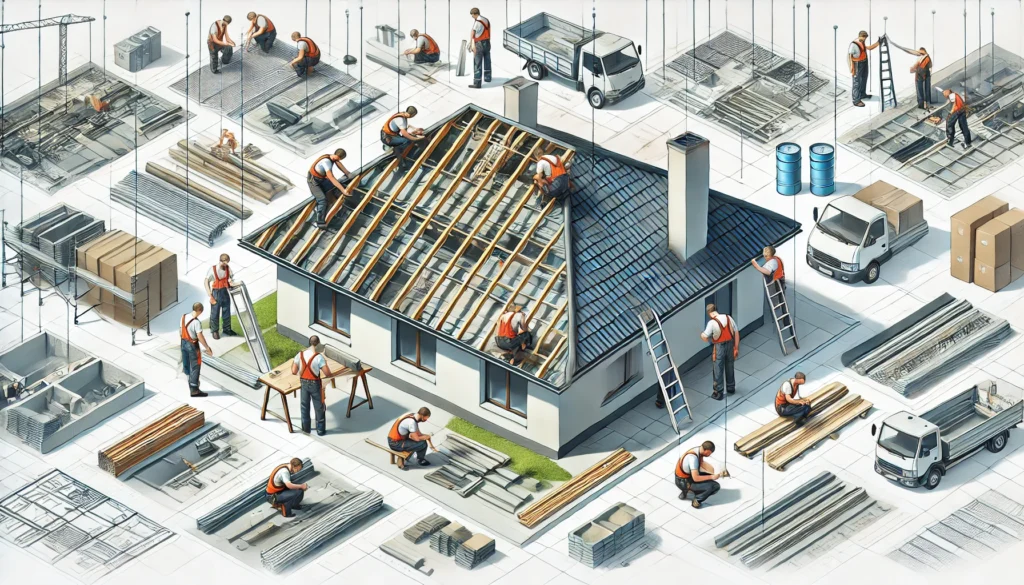
There are a few more home upgrades that can provide protection against extreme weather. Compared to installing a fortified roof, this approach is less impactful. These roofs are capable of withstanding the force of hurricanes, heavy rains, and high winds, a strength that traditional roofing systems lack. This guide outlines the step-by-step process of installing a fortified roof—from choosing materials to selecting a certified installer.
What is a fortified roof?
The Insurance Institute for Business & Home Safety, or IBHS, sets stringent guidelines for the construction of a fortified roof. The engineering of these roofs minimizes storm damage and prevents water intrusion, providing homeowners with peace of mind and potential insurance savings.
Benefits of a Fortified Roof
- Better Protection from Weather Conditions: It can withstand wind speeds reaching up to 130 mph.
- Waterproofing: Reduces water intrusion through sealed roof decks.
- Insurance Discounts: Residents in storm-prone areas qualify for reduced premiums.
- Longevity: It extends the lifespan of your home’s roof.
Step 1: Assess Your Roofing Needs
Before starting the installation process, it’s crucial to evaluate your existing roof and understand your specific needs.
Inspect Your Current Roof
Hire a professional to inspect your roof for structural integrity, damage, and potential weak points.
Understand local requirements
In hurricane-prone states like Louisiana and Mississippi, reinforced roofs are particularly useful. Compare the local building codes and the probability of weather conditions to determine the required reinforcement.
Step 2: Select materials wisely.
Material selection becomes the absolute determining factor for your reinforced roof performance.
Roof Deck
Select a good-quality roof deck. IBHS recommends a 5/8-inch plywood roof deck attached with ring-shank nails.
Roof Deck Sealant
You can apply self-adhering membrane or sealant tape on the spaces between roof deck panels. This will provide waterproof protection.
Durable Roofing Material
Some common materials that can be used for a fortified roof include
- Metal roofing: It is very durable with excellent resistance to weather.
- Impact-resistant shingles are designed to withstand hail and debris.
- Clay tiles add both durability and aesthetic appeal.
Step 3: Choose a Certified Fortified Roof Installer
The right contractor is key to the success of your roofing project.
Look for certification.
Select an IBHS-certified contractor to install fortified roofing. Certification ensures they adhere to strict standards
Check references and reviews.
Ask for references and read online reviews to gauge their reputation and expertise.
Request a detailed estimate.
A transparent estimate should include material costs, labor, and a timeline for project completion.
Step 4: Installation Process: Here’s what to expect during the installation of your fortified roof:
Removing the Old Roof
The contractor takes the roof down to the deck for inspection and prepares any damaged areas for fixing.
Roof Deck Reinforcement
We drive ring-shank nails into the roof deck and seal the areas to prevent water penetration.
Metal Flashing Installation and Drip Edges
Installing metal flashing and drip edges strengthens the roof’s perimeter, enhancing its resistance to wind uplift forces.
Roofing Material Laydown
We install your chosen roofing material—metal, shingles, or tiles—according to IBHS specifications.
Step 5: Final Inspection
A third-party inspector inspects the roof after installation to confirm its adherence to fortified standards. This step is necessary to obtain certification and possible insurance premium savings.
Maintenance Tips for Your Fortified Roof
Maintenance extends your life and keeps your fortified roof in excellent condition.
Schedule annual inspections.
Hire a professional to check for damage and ensure seals are still in place.
Clean debris: After storms, remove leaves and debris to prevent moisture accumulation.
Address repairs promptly.
You should promptly repair even small problems like scratches or loose shingles to prevent further damage to the roof.
Why Sunbelt Roofs for Your Fortified Roofing Services?
At Sunbelt Roofs, we are experts at installing IBHS-certified fortified roofs that protect your home and family.
We have the experience you can count on.
With years of experience working in Louisiana and Mississippi, our team appreciates the nuances associated with roofing during stormy weather conditions.
All roofing services
Our commitment is to handle everything with the utmost professionalism, from initial consultations to the final inspection.
Outstanding Customer Service
We’re committed to delivering clear communication and excellent service to ensure that you are satisfied from the beginning to the end.
Contact Sunbelt Roofs Today.
Are you prepared to transition to a stronger roof? Reach out to Sunbelt Roofs right now for a consultation. Call Us Now! Louisiana: (985) 805-6921 | Mississippi: (228) 222-5255
Fortify your house with a roof that will last. Contact Sunbelt Roofs and experience the difference!
